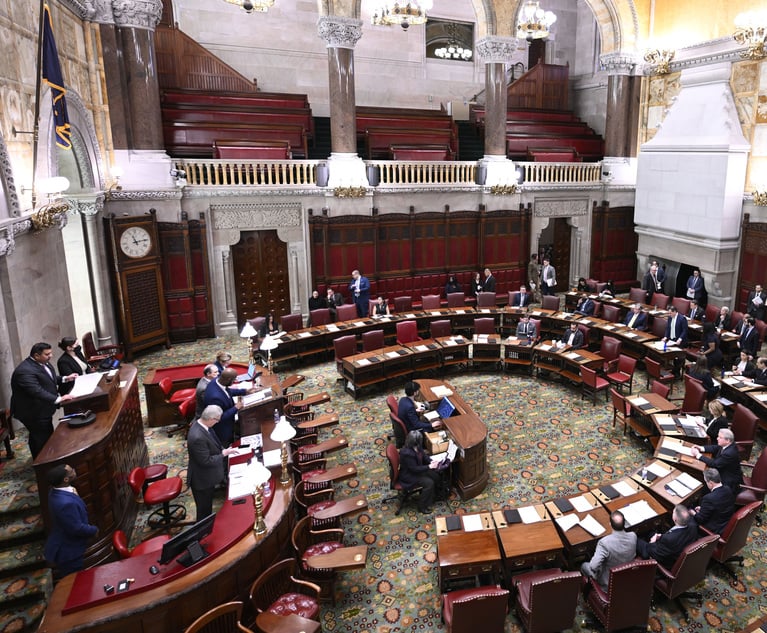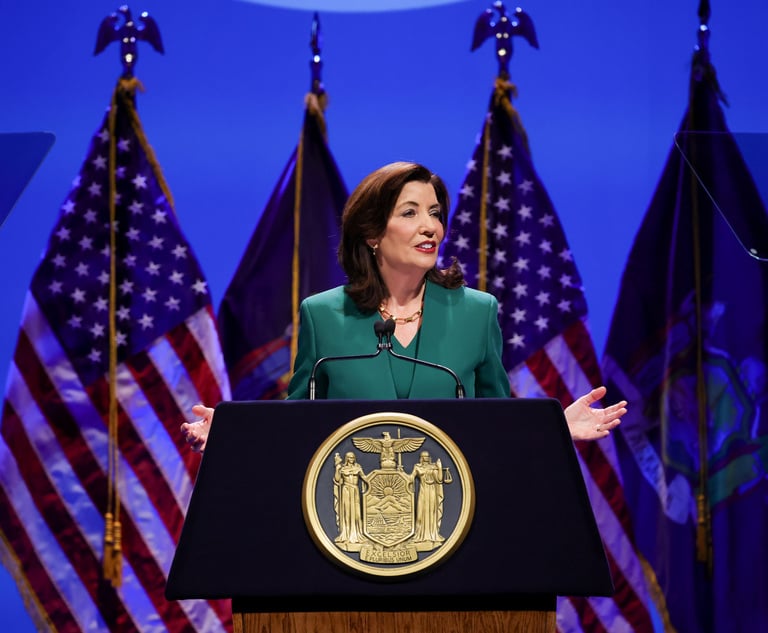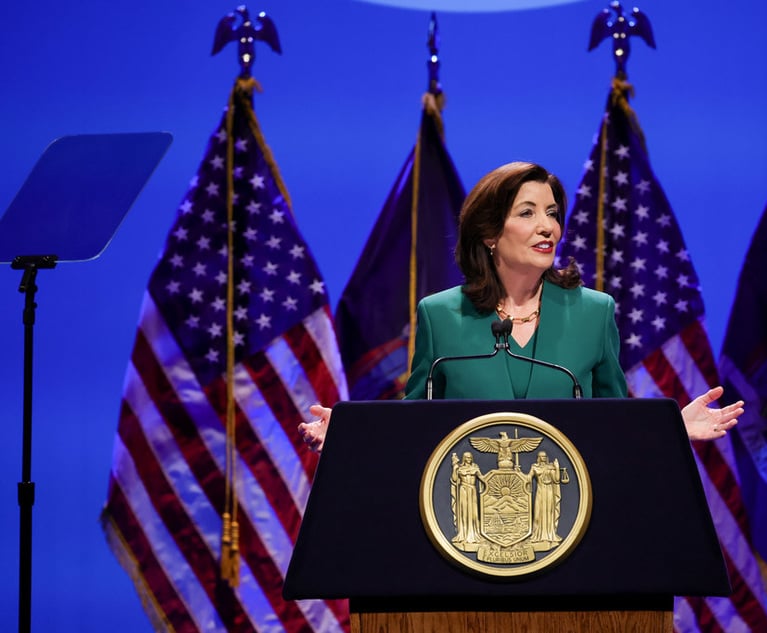Unreasonable Force That Kills: A Proposal for Reliable Criminal Justice
A discussion of the need for legislative change to address the issue of the use of excessive force by police officers, including proposed amendments to the New York State Penal Law, a new chapter entitled "Excessive Force by Police Officers."
June 12, 2020 at 10:15 AM
12 minute read
 Marc Frazier Scholl and Adam S. Kaufmann
Marc Frazier Scholl and Adam S. Kaufmann
The horrific use of brutal force against George Floyd has sparked widespread outrage, calls for change, and dialogues about many issues that are long overdue. Our country in 2020 finds itself at a crossroad, seeking a path to address many aspects of racial injustice. A focal point of this broader conversation, and the flashpoint for much of the anger and frustration felt by so many in the wake of Mr. Floyd's death and the deaths of so many others, is how to address the use of excessive force by police officers.
The story of George Floyd is merely one example of a specific failure in this country that has repeated itself far too often. The failure has been ongoing for a long time. But, only in recent years, with the advent of widespread personal and commercial video equipment, has proof of the failure become incontrovertible. And, yes, while the failure can affect people of all hues and backgrounds; primarily, the victims of this failure are people of color.
Each time the failure is publicized there are calls for better training. But to date training alone has not changed the failure. Civil lawsuits have not changed the failure. Publicity has not changed the failure. There is likely no one fix to the failure. But the time is long past due for part of the solution to be accountability for bad police officers whose unreasonable conduct results in serious injury or death. Pervasive change from within police departments is necessary but difficult to measure, and difficult to achieve with confidence in the short term. Legislative action is necessary as a driver of change. To advance the dialogue, we put forth a legislative model for change in New York.
We do not attempt in this note to address in broad terms the issues of racism in policing or in society as a whole. Police training, economic justice, and issues of inherent bias and racism are rightly at the forefront of a political discourse today. The elimination of racism cannot be legislated. Community involvement and education—by police and civilians alike—are likely the appropriate avenues to advance these goals.
We focus instead on one specific issue—the use of excessive force by police officers—and propose amendments to the criminal laws dealing with this issue. In doing so, we seek to create a clear analytic paradigm focused on whether force used by a police officer was objectively reasonable, and to hold accountable criminally both those who use excessive force and those who stand by and do nothing or cover up such misconduct.
Police officers are called upon to undertake tasks that are often difficult, dangerous, even life-threatening. To do their jobs, police officers are given rights and authority not entrusted to civilians, including the right to use force—even deadly force—to enforce the laws. But with power and authority come responsibilities; chief among them to treat the populace they protect and serve with dignity and respect. Boiled down, to act reasonably when they utilize force to perform their lawful duties. And when they do not act reasonably, and individuals suffer serious injury or death as a result, there is no reason police officers should not be subject to criminal prosecution.
One impediment to prosecution is the absence of laws clearly addressing the use of unreasonable force by police officers. The laws employed in such cases are generally adapted from other areas of law and fail to address adequately the circumstance of use of force by police, as distinguished from use of force by civilians.
A good example is the case brought against former police officer Derek Chauvin. The top count against him, second-degree murder under Minnesota law, requires the prosecution to show that Floyd's death occurred during the commission of another felony—assault. This means that the prosecution will have to prove that Chauvin acted with the specific intent to assault Floyd. We can predict that the trial will come down to a focus of whether Chauvin intended to assault Floyd, or whether his intent was to restrain him. This inquiry misses the point entirely. The focus should be on whether Chauvin acted reasonably or unreasonably. If he intentionally acted in a manner that a jury finds was objectively unreasonable, and as a result of his actions Floyd died, then he should be criminally culpable for his conduct.
Similarly, the laws in New York State do not truly capture a crime of excessive force. Penal Law Article 30 provides for a justification defense in the use of force and deadly force. This law does not view excessive force as a crime unto itself, but rather calls for an analysis of whether the use of force by the officer was justified in the circumstances. Its formulations, built around the concept of what the officer "reasonably believed" are often confusing and unwieldy.
By its structure, the law of justification as applied to police officers requires the government, in part, to prove a negative—that the defendant was not justified beyond a reasonable doubt. By predicating its framework on an initial review of the police officer's subjective beliefs, regardless of whether those beliefs are objectively unreasonable, current law unintentionally and perversely protects the unprofessional and untrained.
For cases involving allegations of unreasonable force by police officers, a different analytic paradigm might be considered. One that does not require proof of double negatives or inquiries into the subjective belief of the officer. Such a standard would rely on proof of what is objectively reasonable under all of the circumstances. It does not require that the officer be right, but it does take into account whether, considering all the apparent circumstances, the officer's conduct was reasonable.
The Supreme Court has spoken of reasonableness as the touchstone in terms of civil liability in civil rights actions. "The "reasonableness" of a particular use of force must be judged from the perspective of a reasonable officer on the scene, rather than with the 20/20 vision of hindsight." Graham v. Connor, 490 U.S. 386, 396 (1989). Unfortunately, while the standard made sense, subsequent civil rights cases predicated on fourth amendment violations diluted the standard through qualified immunity doctrines. For a reasonableness standard to work, a reasonable officer must be viewed as a trained police officer, one who has an understanding of his or her role and who has been trained to approach that role with respect for the population being served and protected.
Moreover, the focus of such an excessive force statute is not on the split-second decisions that govern whether and if an officer needs to use force to effectuate an arrest or to protect himself or herself. Instead, such a statute focuses on how the police control their encounters with citizens. How do the police deal with the occupant of a stopped vehicle, or an already handcuffed and restrained suspect, a person suspected of a nonviolent minor infraction, or simply a recalcitrant citizen who does not wish to interact with the officer? At the core of an excessive force statute is the concept that officers should be reasonable in deciding the force to utilize at every step of the encounter.
Hopefully such a statute will encourage police officers to consider the force they employ in any given circumstance, and to de-escalate encounters where possible. An officer seeing someone raising what under the circumstances reasonably appears to be a weapon and who fires defending himself should have no fear of prosecution. His or her use of force may not be unreasonable under the circumstances—even if it turns out that what the person was raising was a stick, a wallet, or possibly even a hand. Mistakes will happen—even tragic mistakes, and they should not be prosecuted as crimes.
On the other hand, the officer who tasers a restrained prisoner causing the prisoner to suffer a heart attack, or the officers who beat a handcuffed prisoner causing serious physical injury, have not acted reasonably under any objective standard and should be prosecuted. We should expect our police officers to be professionals at assessing risk and avoiding causing unnecessary injury or death. Too often, they are held to a lesser rather than a higher standard than ordinary citizens, simply because they are police.
Finally, we also believe that police officers for too long have been encouraged by an "us v. them" attitude to stand by or look the other way when another police officer utilizes excessive force. The Penal Law currently has no prohibition assigning culpability to an officer who fails to act when he or she should. This must end. To address the culture of the blue wall of silence, we also further suggest new statutes to address (1) officers who fail to reasonably intercede when a fellow officer is utilizing excessive force or fail to report such conduct and (2) officers who participate in cover-ups to obstruct an excessive force investigation or prosecution.
We recognize that the extension of the penal law to "failures to act" is something of a novel concept. But we also note that police officers are charged with enforcing the law against everyone—including their own. A police officer who turns his back on an assault by a civilian is derelict in his duty. It is long past time to impose a duty on police officers as a body to show restraint and intervene when one of their own transgresses.
The pervasive availability of video images has revealed that police transgressions are much more widespread than previously believed. In times past allegations of unreasonable force relied on the word of the arrested criminal against the word of the police officer. Today, video images are placing the lie to many such police accounts. But as former prosecutors and current defense attorneys we feel compelled to sound a note of caution.
The images seared into our collective conscious from Minneapolis and other unforgivable incidents must rest alongside other images of cops streaming into the burning twin towers or running toward the sound of gunfire to face armed assailants. A new balance must be calibrated, but it must be done with thought and care.
In that regard, we propose the following amendments to the New York State Penal Law, a new chapter entitled "Excessive Force by Police Officers," including the following offenses:
- Use of Excessive Force in the First Degree (Excessive Force Resulting in Death)
- Use of Excessive Force in the Second Degree (Excessive Force Resulting in Serious Physical Injury)
- Failure to Intervene or Report Use of Excessive Force
- Obstruction of Justice Relating to Excessive Force
- Rebuttable Presumption Relating to Use of Excessive Force.
S XXX.10 Excessive Force in the First Degree (proposed class B felony)
A person is guilty of excessive force in the first degree when, regardless of whether he has a legal right to restrain another person and notwithstanding Penal Law section 35.30, he intentionally uses force to restrain such other person and such force is unreasonable under the circumstances and such force proximately results in the death of such other person.
S XXX.15 Excessive Force in the Second Degree (proposed class C felony)
A person is guilty of excessive force in the second degree when, regardless of whether he has a legal right to restrain another person and notwithstanding Penal Law section 35.30, he intentionally uses force to restrain such other person and such force is unreasonable under the circumstances and such force proximately results in serious physical injury to such other person.
S XXX.20 Failure to Intervene or Report Excessive Force (proposed class E felony)
A person is guilty of failure to intervene or report excessive force when, while participating in the restraint of another person under circumstances that result in the use of unreasonable force causing the death of that person or serious physical injury to that person, he fails to take reasonable steps to stop the use of such unreasonable force, or fails to report the use of such unreasonable force at the earliest reasonable time to superiors.
S XXX.25 Obstruction of Justice Relating to Excessive Force (proposed class C felony)
A person is guilty of obstruction of justice relating to excessive force when, believing that an investigation or prosecution of a crime set forth in this chapter is commenced or ongoing, he intentionally provides false information to any police officer or prosecutor investigating or prosecuting such matter.
S XXX.30 Rebuttable Presumption in the Use of Excessive Force
In the prosecution of such offenses as described in this chapter, there shall be a rebuttable presumption that a person who meets the definition of "Peace Officer" or "Police Officer" as set forth in Criminal Procedure Law 1.20(33) or 1.20(34), who violates the guidelines in the use of force issued or required by that person's employer, has acted unreasonably under the circumstances.
What is being proposed is not a panacea. But we hope these proposals become part of a larger conversation about race, policing, and the use of force.
Marc Frazier Scholl is counsel at Lewis Baach Kaufmann Middlemiss. Adam Kaufmann is a partner at the firm. Partners Eric Lewis, Art Middlemiss, Anthony Capozzolo, Jason Berland, and senior counsel John Moscow, assisted in the preparation of this article.
This content has been archived. It is available through our partners, LexisNexis® and Bloomberg Law.
To view this content, please continue to their sites.
Not a Lexis Subscriber?
Subscribe Now
Not a Bloomberg Law Subscriber?
Subscribe Now
NOT FOR REPRINT
© 2025 ALM Global, LLC, All Rights Reserved. Request academic re-use from www.copyright.com. All other uses, submit a request to [email protected]. For more information visit Asset & Logo Licensing.
You Might Like
View All
Relaxing Penalties on Discovery Noncompliance Allows Criminal Cases to Get Decided on Merit
5 minute read
Bipartisan Lawmakers to Hochul Urge Greater Student Loan Forgiveness for Public-Interest Lawyers

'Playing the Clock'?: Hochul Says NY's Discovery Loophole Is to Blame for Wide Dismissal of Criminal Cases

So Who Won? Congestion Pricing Ruling Leaves Both Sides Claiming Victory, Attorneys Seeking Clarification
4 minute readLaw Firms Mentioned
Trending Stories
- 1Gibbons Reps Asylum Seekers in $6M Suit Over 2018 ‘Inhumane’ Immigration Policy
- 2DC Judge Chutkan Allows Jenner's $8M Unpaid Legal Fees Lawsuit to Proceed Against Sierra Leone
- 3Internal Whistleblowing Surged Globally in 2024, so Why Were US Numbers Flat?
- 4In Resolved Lawsuit, Jim Walden Alleged 'Retaliatory' Silencing by X of His Personal Social Media Account
- 5Government Attorneys Face Reassignment, Rescinded Job Offers in First Days of Trump Administration
Who Got The Work
J. Brugh Lower of Gibbons has entered an appearance for industrial equipment supplier Devco Corporation in a pending trademark infringement lawsuit. The suit, accusing the defendant of selling knock-off Graco products, was filed Dec. 18 in New Jersey District Court by Rivkin Radler on behalf of Graco Inc. and Graco Minnesota. The case, assigned to U.S. District Judge Zahid N. Quraishi, is 3:24-cv-11294, Graco Inc. et al v. Devco Corporation.
Who Got The Work
Rebecca Maller-Stein and Kent A. Yalowitz of Arnold & Porter Kaye Scholer have entered their appearances for Hanaco Venture Capital and its executives, Lior Prosor and David Frankel, in a pending securities lawsuit. The action, filed on Dec. 24 in New York Southern District Court by Zell, Aron & Co. on behalf of Goldeneye Advisors, accuses the defendants of negligently and fraudulently managing the plaintiff's $1 million investment. The case, assigned to U.S. District Judge Vernon S. Broderick, is 1:24-cv-09918, Goldeneye Advisors, LLC v. Hanaco Venture Capital, Ltd. et al.
Who Got The Work
Attorneys from A&O Shearman has stepped in as defense counsel for Toronto-Dominion Bank and other defendants in a pending securities class action. The suit, filed Dec. 11 in New York Southern District Court by Bleichmar Fonti & Auld, accuses the defendants of concealing the bank's 'pervasive' deficiencies in regards to its compliance with the Bank Secrecy Act and the quality of its anti-money laundering controls. The case, assigned to U.S. District Judge Arun Subramanian, is 1:24-cv-09445, Gonzalez v. The Toronto-Dominion Bank et al.
Who Got The Work
Crown Castle International, a Pennsylvania company providing shared communications infrastructure, has turned to Luke D. Wolf of Gordon Rees Scully Mansukhani to fend off a pending breach-of-contract lawsuit. The court action, filed Nov. 25 in Michigan Eastern District Court by Hooper Hathaway PC on behalf of The Town Residences LLC, accuses Crown Castle of failing to transfer approximately $30,000 in utility payments from T-Mobile in breach of a roof-top lease and assignment agreement. The case, assigned to U.S. District Judge Susan K. Declercq, is 2:24-cv-13131, The Town Residences LLC v. T-Mobile US, Inc. et al.
Who Got The Work
Wilfred P. Coronato and Daniel M. Schwartz of McCarter & English have stepped in as defense counsel to Electrolux Home Products Inc. in a pending product liability lawsuit. The court action, filed Nov. 26 in New York Eastern District Court by Poulos Lopiccolo PC and Nagel Rice LLP on behalf of David Stern, alleges that the defendant's refrigerators’ drawers and shelving repeatedly break and fall apart within months after purchase. The case, assigned to U.S. District Judge Joan M. Azrack, is 2:24-cv-08204, Stern v. Electrolux Home Products, Inc.
Featured Firms
Law Offices of Gary Martin Hays & Associates, P.C.
(470) 294-1674
Law Offices of Mark E. Salomone
(857) 444-6468
Smith & Hassler
(713) 739-1250






